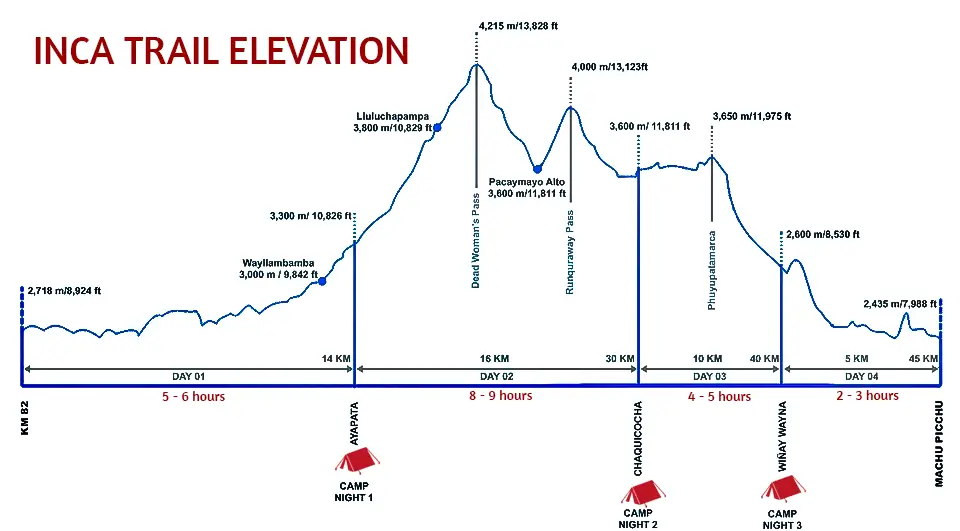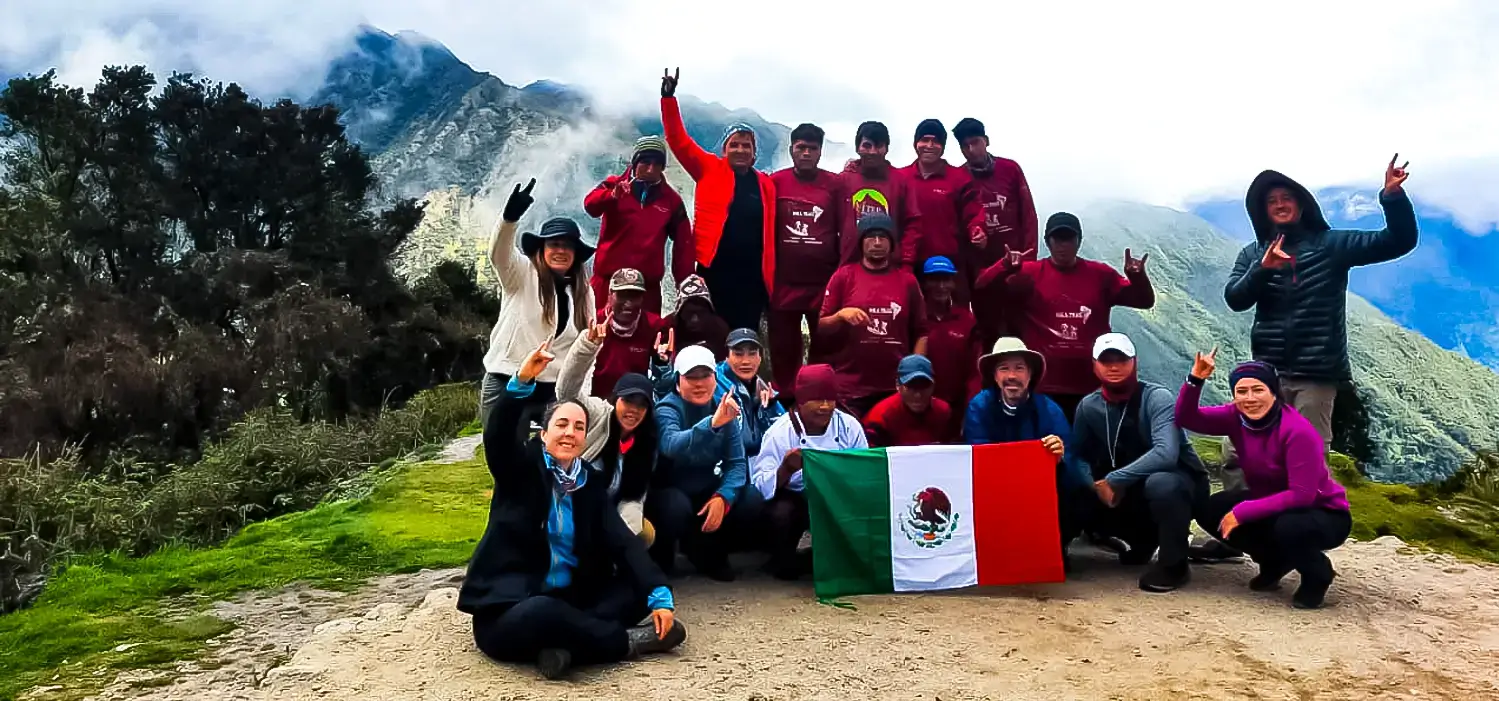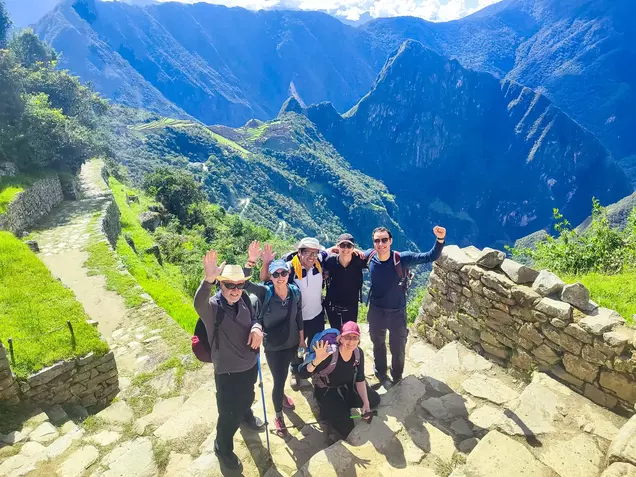
The famous Inca Trail to Machu Picchu stands out as one of the most renowned trekking routes in the world. However, it is also recognized for being one of the most demanding and challenging treks in Perú, with an average elevation of 1,000 meters and peaking at 4,215 meters above sea level. Hikers interested in this adventure should book in advance and prepare adequately to face this experience
Elevation is an important factor to consider on the Inca Trail. When you reach 4,215 meters, its highest point, you face a considerable challenge, with an altitude almost double that of Cuzco. This elevation can cause breathing difficulties, fatigue, headaches and nausea due to the reduction in air density.
It is essential to acclimatize to these altitudes before starting the trek. It is recommended to spend a few days in Cuzco (located at 3,400 meters above sea level) to gradually adapt. During the trek, it is crucial to take the necessary time for the body to adjust, making frequent stops and being attentive to any symptoms of altitude sickness. Most people experience mild symptoms that disappear with time, but it is essential to seek medical help if unusual complications arise
Renowned as one of the most challenging hikes globally, the Inca Trail presents an exhilarating adventure. Spanning 26 miles (42 km) across Peru's Andes Mountains, this four-day journey offers unparalleled experiences. With altitudes soaring up to 13,828 feet (4,215m), various elements contribute to its formidable nature.

The Inca Trail winds through the majestic Andes Mountains, renowned for its diverse climate patterns. While generally temperate, weather conditions along this high-altitude route can shift swiftly, necessitating thorough preparation for all eventualities.
Protection from the sun with sunscreen and a hat is imperative during daylight hours, while the evenings often bring a sharp decrease in temperature, making it advisable to carry a jacket for added warmth.
As nights can turn chilly, it's recommended to bring along a high-quality sleeping bag. Given the likelihood of rain, packing waterproof gear is essential. Furthermore, sturdy waterproof boots are essential to navigate occasional muddy trails and the possibility of snowfall.

Cusco encounters its rainy period from December through March, leading to the closure of the Inca Trail in February for upkeep and due to heavy rainfall. Embarking on the Inca Trail during this time presents both advantages and disadvantages.
For those considering hiking the Inca Trail during the rainy season, it's vital to come equipped with suitable attire – including raincoats, pants, and waterproof boots – to ensure a comfortable journey.
The dry season on the Inca Trail spans from May to September. While the weather typically tends to be more favorable during this time, occasional showers can still occur unexpectedly, so it's important to pack rain gear.
The dry season marks the peak period for Inca Trail trekking, making it essential to secure permits well in advance. With limited spaces available on the trail each day, early booking is crucial
Expect some crowds when hiking the Inca Trail, as it is one of the world's most popular routes, especially during the dry season when it can get quite crowded. If you prefer a more secluded experience, consider exploring one of Peru's less frequented paths instead.
The shoulder seasons, which include April-May and September-October, are ideal for trekking the Inca Trail. These periods offer milder weather conditions compared to the extremes of the wet season from December to March. While there may still be some rain, it tends to be less intense, providing more comfortable hiking experiences.
Embarking on the Inca Trail promises an epic and exhilarating journey, renowned for its challenging terrain with steep ascents and rapid altitude changes. Proper preparation is paramount for trekkers venturing into this terrain. Despite its demanding nature, the Inca Trail offers an unforgettable experience suitable for most moderate and experienced hikers. However, meticulous preparation is essential before setting foot on this iconic trail.

Upon reaching Machu Picchu, take pleasure in unwinding and exploring one of the globe's most renowned archaeological marvels.
After completing the challenging trek along the Inca Trail to Machu Picchu, it's crucial to prioritize rest and recuperation. Here are some recommendations for activities you should consider:
After allowing yourself a day or two of rest, you can venture out to explore additional destinations such as the Rainbow Mountain and Red Valley Tour.

Commitment to quality, we have ISO 9001, ensuring excellence in our services.

With ISO 14001 we prioritize environmental sustainability, reducing our impact on the planet.

We are an official agency and tour operator, ensuring a unique and high quality travel experience.

Traveler's Choice Award in 2023, a testament to our dedication to exceptional travel experiences.